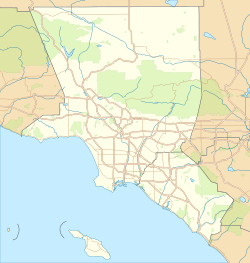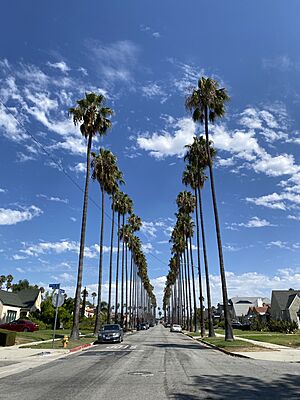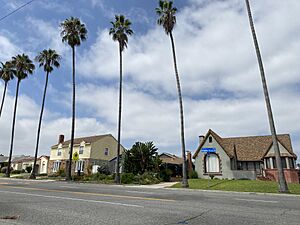View Park–Windsor Hills, California facts for kids
Quick facts for kids
View Park−Windsor Hills, California
|
|
|---|---|
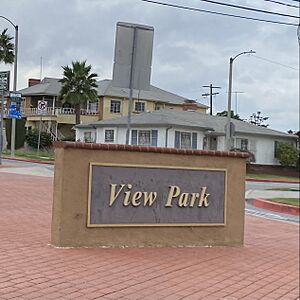 |
|
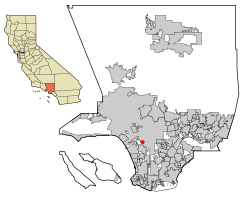
Location of View Park−Windsor Hills in Los Angeles County, California.
|
|
| Country | United States |
| State | California |
| County | Los Angeles |
| Area | |
| • Total | 1.842 sq mi (4.771 km2) |
| • Land | 1.841 sq mi (4.769 km2) |
| • Water | 0.001 sq mi (0.002 km2) 0.04% |
| Population
(2020)
|
|
| • Total | 11,419 |
| • Density | 6,199.2/sq mi (2,393.4/km2) |
| Time zone | UTC-8 (Pacific) |
| • Summer (DST) | UTC-7 (PDT) |
| ZIP Code |
90043
|
| Area code(s) | 323 |
| FIPS code | 06-82667 |
View Park−Windsor Hills is a special kind of community in Los Angeles County, California. It's called an "unincorporated community" because it's not officially a city, but it still has a lot of people living there.
The area is made up of two main parts: View Park and Windsor Hills. View Park is around Angeles Vista Boulevard, and Windsor Hills is further south, near Slauson Avenue.
View Park−Windsor Hills is known for being one of the wealthiest neighborhoods in the United States where many African-American families live. It's part of a larger group of neighborhoods that form a strong, historically black community in the Western United States. These areas include Baldwin Hills and Ladera Heights.
The community was built between 1923 and 1970. While it's still mostly African-American, more white and Asian families are moving in. Many of these new residents work in nearby places like Culver City and Downtown Los Angeles.
In 2020, about 11,419 people lived in View Park-Windsor Hills.
Contents
History of the Community
How View Park Started
View Park was developed between 1923 and 1970. It was planned as an upscale neighborhood by the same people who developed Hancock Park. Today, it's one of the richest African-American areas in the U.S.
The neighborhood has many beautiful houses and mansions. They are built in styles like Spanish Colonial Revival and Mid-Century. Many famous architects designed homes here, including Paul Williams. One of his documented homes is at 4351 Mount Vernon Drive.
The Story of Windsor Hills
Windsor Hills was built a bit later, starting in the late 1930s. It was special because it was the first neighborhood in Southern California to get help from the Federal Housing Administration for home loans.
Like View Park, Windsor Hills also features homes in Spanish Colonial Revival and Mediterranean Revival styles. For a long time, African-Americans were not allowed to live in either View Park or Windsor Hills. This changed in 1948 when the Supreme Court made rules against such restrictions.
Geography and Climate
Understanding the Area
View Park−Windsor Hills covers about 1.8 square miles (4.7 square kilometers) of land.
Local Weather
The area has a warm-summer Mediterranean climate. This means it has warm, dry summers and mild, wet winters.
Who Lives Here: Demographics
Population Changes Over Time
The United States Census Bureau tracks information about View Park−Windsor Hills. In 2020, View Park-Windsor Hills was ranked as one of the top 10 richest Black communities in the U.S. The average family income was about $159,168.
| Historical population | |||
|---|---|---|---|
| Census | Pop. | %± | |
| 1970 | 12,268 | — | |
| 1980 | 12,101 | −1.4% | |
| 1990 | 11,769 | −2.7% | |
| 2000 | 10,958 | −6.9% | |
| 2010 | 11,075 | 1.1% | |
| 2020 | 11,419 | 3.1% | |
| U.S. Decennial Census 2010 2020 |
|||
Community Makeup in 2020
Here's a look at the different groups of people living in View Park-Windsor Hills in 2020:
| Race / Ethnicity (NH = Non-Hispanic) | Pop 2000 | Pop 2010 | Pop 2020 | % 2000 | % 2010 | % 2020 |
|---|---|---|---|---|---|---|
| White alone (NH) | 530 | 463 | 1,004 | 4.84% | 4.18% | 8.79% |
| Black or African American alone (NH) | 9,557 | 9,209 | 8,048 | 87.21% | 83.15% | 70.48% |
| Native American or Alaska Native alone (NH) | 12 | 18 | 9 | 0.11% | 0.16% | 0.08% |
| Asian alone (NH) | 122 | 143 | 319 | 1.11% | 1.29% | 2.79% |
| Pacific Islander alone (NH) | 7 | 4 | 10 | 0.06% | 0.04% | 0.09% |
| Other race alone (NH) | 38 | 45 | 87 | 0.35% | 0.41% | 0.76% |
| Mixed race or Multiracial (NH) | 395 | 473 | 844 | 3.60% | 4.27% | 7.39% |
| Hispanic or Latino (any race) | 297 | 720 | 1,098 | 2.71% | 6.50% | 9.62% |
| Total | 10,958 | 11,075 | 11,419 | 100.00% | 100.00% | 100.00% |
Arts and Culture in the Community
A Place of History
On July 12, 2016, View Park was added to the National Register of Historic Places. This is a special list of places important to American history. It was a big effort by local residents who raised money to make it happen. View Park is now the largest historic district in the country based on African American history. It's also the largest in California by the number of property owners.
Community Library
The community has its own library, the County of Los Angeles Public Library View Park Library. It's named after Bebe Moore Campbell, a famous writer who lived in the community.
Famous Landmarks
- The home of music legend Ray Charles is at 4863 Southridge Avenue. It was built in 1965.
- The unique Googie-style building, once called the Wich Stand, is now Simply Wholesome. You can find it at Slauson Avenue and Overhill Avenue.
- The Doumakes House is the first historic landmark in this part of Los Angeles County. It's located at Angeles Vista Blvd and West Blvd.
Parks and Recreation
View Park-Windsor Hills has a main park called Rueben Ingold Park. This park opened in 1971. It's right next to the Kenneth Hahn State Recreation Area. A new path, the Stocker Trail Corridor, connects the two parks. Many residents also use the Valley Ridge Avenue hill for exercise.
- Further information: Park to Playa Trail
Education for Students
Local Schools
The schools in View Park-Windsor Hills are mostly part of the Los Angeles Unified School District. Some parts are also in the Inglewood Unified School District.
Here are some of the elementary schools in the LAUSD part of the community:
- 54th Street Elementary School (Kindergarten to 5th grade)
- Cowan Elementary School (1st to 5th grade)
- Windsor Math/Science/Aerospace Magnet (Kindergarten to 5th grade)
For middle school, students usually go to Audubon Middle School. For high school, students attend Crenshaw High School or View Park Preparatory High School. View Park Preparatory High School is a special school that works with LAUSD.
Community Services
Police and Safety
The Los Angeles County Sheriff's Department provides police services for the community. They patrol the area and respond to emergencies. The California Highway Patrol (CHP) handles traffic laws. The Los Angeles Unified School District Police also looks after the school campuses.
Fire and Medical Help
Fire and emergency medical services are provided by the Los Angeles County Fire Department. They have fire stations nearby that respond to fires and medical calls.
Famous People from View Park-Windsor Hills
Many well-known people have lived in View Park-Windsor Hills, including actors, athletes, filmmakers, and musicians:
- Ermias Joseph Asghedom, known as Nipsey Hussle (musician)
- Angelle Brooks, actress
- Charles Burnett, filmmaker
- Laphonza Butler, US Senator
- Bebe Moore Campbell, novelist
- Ray Charles, singer
- Doria Ragland, mother of Meghan, Duchess of Sussex
- James Cleveland, gospel singer
- Michael Cooper, former NBA player
- Loretta Devine, actress
- Curt Flood, baseball player
- Regina King, Academy Award-winning actress
- Mike Love, musician (from The Beach Boys)
- Marilyn McCoo, singer
- Meghan, Duchess of Sussex, member of the British Royal Family
- Issa Rae, writer and actress
- Ike & Tina Turner, music duo
- Nancy Wilson, vocalist
See also
 In Spanish: View Park-Windsor Hills para niños
In Spanish: View Park-Windsor Hills para niños


